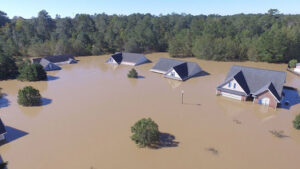Battered by the relentless fury of Atlantic storms, Coastal North Carolina stands as a resilient beacon of fortitude. However, beneath its picturesque coastal charm lies a challenging reality – a vulnerability to the unforgiving might of hurricanes, tropical storms, and tempestuous weather events. In the relentless dance with nature, the importance of maintaining healthcare services during these tumultuous episodes becomes not just an imperative but a lifeline.
Join us as we unveil the vital role of medical readiness in safeguarding the well-being of Coastal North Carolina’s residents and discover the stories of dedication and innovation that define this remarkable coastal region’s resilience.
Coastal North Carolina’s Vulnerability to Storms
 Image Source: Kera News
Image Source: Kera News
Coastal North Carolina has a history of recurring hurricanes and tropical storms, each leaving a unique imprint on the region’s landscape and its people.
The region’s susceptibility to storms is deeply intertwined with its geographical features, including its extensive coastline and the convergence of ocean currents, creating a fertile ground for storm development. Its thriving communities and growing population density accentuate the need for robust healthcare services during storms, adding to the complexity of disaster response.
Specific segments of the population, including the elderly, individuals with disabilities, low-income households, and those with chronic health conditions, face unique challenges during storms, requiring tailored preparedness measures and support.
Within the vibrant tapestry of Coastal North Carolina’s population, certain segments are particularly susceptible to the challenges presented by storms. Vulnerable populations, such as the elderly, individuals with disabilities, low-income households, and those with chronic health conditions, require special attention and care during storm events. Evacuation and access to healthcare services are often more complex for these groups, necessitating tailored preparedness measures and support.
In the face of these challenges, Coastal North Carolina has shown unwavering resilience and a steadfast commitment to protecting its residents. The article will continue to explore how the healthcare system in the region rises to the occasion, safeguarding lives and aiding the community during its most trying times.
Medical Facilities and Resources
In Coastal North Carolina, a spectrum of medical facilities and resources plays a vital role in ensuring healthcare continuity during storms. Hospitals, strategically located with ample capacity, are fortified with emergency preparedness plans and essential specialized services. Clinics and urgent care centers offer accessible non-emergency care, easing the strain on hospitals.
Nursing homes and long-term care facilities are well-prepared to safeguard vulnerable populations. Ambulance services ensure timely patient transport, and the region’s dedicated medical personnel stand ready to provide essential care. This interwoven healthcare network forms the bedrock of Coastal North Carolina’s medical readiness, even in the face of challenging weather events.
Pre-Storm Preparedness
Pre-storm readiness in Coastal North Carolina encompasses several key components:
A. Emergency Response Plans
Healthcare facilities within the region maintain comprehensive emergency response plans, serving as well-structured guides for patient care, facility protection, and collaboration with local authorities. These plans ensure an organized and effective response when the storm strikes.
B. Evacuation Procedures
The region has finely tuned evacuation procedures in place, designed to ensure the safe relocation of patients and residents to secure locations. These plans prioritize the safety of vulnerable populations and aim to maintain a continuous provision of care, even amidst the challenging circumstances of an evacuation.
C. Stockpiling of Medical Supplies
Healthcare facilities stockpile essential medical supplies and medications in anticipation of potential supply chain disruptions during storms. These stockpiles act as a lifeline, ensuring that essential care and treatment can continue, regardless of storm-related challenges.
D. Communication Systems
Robust communication systems are in place, allowing for real-time information exchange. These systems facilitate the coordination of evacuation efforts, the assessment of resource needs, and the crucial task of keeping healthcare personnel and the general public informed about storm-related developments.
These preparations collectively serve as Coastal North Carolina’s shield against the impending storm, ensuring the health and safety of its communities.
During the Storm
 Image Source: Wade Austin Ellis on Unsplash
Image Source: Wade Austin Ellis on Unsplash
As the storm’s onslaught begins, Coastal North Carolina’s healthcare system swings into action, demonstrating remarkable resilience and commitment to ensure the continuous delivery of care and safety during these tumultuous conditions.
Within healthcare facilities, a dual focus is maintained. First and foremost, Patient Care remains a top priority. Despite the storm’s challenges, dedicated medical staff continue providing essential medical attention, ensuring patient needs are met without compromise.
Simultaneously, Staff Safety is meticulously safeguarded. Measures are put in place to protect healthcare personnel, allowing them to carry out their vital work while minimizing personal risk.
Collaboration with local authorities is a linchpin of the storm response. Healthcare facilities work in close partnership with local agencies, ensuring the efficient allocation of resources, the management of emergency services, and the establishment of clear and open communication channels. This cooperation is pivotal in effectively addressing the challenges that the storm presents.
Telemedicine emerges as a critical tool during the storm, enabling remote medical consultations and support. This technology ensures that patients can access timely medical advice and guidance, even when traveling to a healthcare facility may be hazardous or impossible due to inclement weather.
The tempestuous conditions of the storm bring forth a series of formidable challenges. Power outages, infrastructure damage, and transportation difficulties loom large. Yet, through its adaptable response, the healthcare system rises to the occasion, deftly managing these obstacles and ensuring that the provision of care continues undeterred.
In the heart of the storm, Coastal North Carolina’s healthcare system shines as a beacon of resilience and dedication, unwavering in its commitment to providing vital services to those in need.
Post-Storm Recovery
After the tempest’s departure, the healthcare system of Coastal North Carolina shifts into high gear, commencing a determined post-storm recovery phase. First, the extent of damage to medical facilities is meticulously assessed, forming the bedrock for focused restoration efforts and efficient resource allocation. Swift restoration of services is paramount, involving repairing and reequipping facilities, reassembling medical personnel, and resuming patient care while upholding the highest standards of safety and quality.
The post-storm period also demands a vigilant response to address medical emergencies that often arise in its aftermath, ranging from storm-related injuries to exacerbated chronic conditions due to stress and disruption. This requires the mobilization of resources and personnel, ensuring that additional medical staff, supplies, and support services are promptly deployed to areas in need. In this phase, the healthcare system reveals its unwavering resilience and commitment to swiftly recover and resume critical medical services, exemplifying its dedication to the health and well-being of Coastal North Carolina’s residents.
Challenges and Gaps
 Image Source: NC Health News
Image Source: NC Health News
Despite the remarkable resilience of Coastal North Carolina’s healthcare system in the face of storms, it is not without its share of challenges and identified gaps. First, there are Identified Weaknesses in the current healthcare system, including vulnerabilities that become apparent during storm events. These weaknesses often revolve around the strain on resources, manpower, and infrastructure, which are put to the test under extreme conditions.
Second, the system contends with resource and funding challenges, where the need for additional resources and funding to enhance preparedness and response capabilities becomes evident. Ensuring the consistent availability of necessary resources, such as medical supplies and personnel, demands strategic planning and a reliable financial framework.
Finally, regulatory and policy issues can present obstacles to a seamless healthcare response. Overcoming regulatory hurdles and ensuring that policies are agile and adaptable to evolving storm scenarios is crucial in optimizing the healthcare system’s ability to provide uninterrupted care during storms. These challenges and gaps underscore the importance of ongoing efforts to bolster medical readiness in the region and create a more resilient healthcare system.
Wrapping Up
In summary, our investigation has illuminated the strengths, weaknesses, and imperative of Coastal North Carolina’s medical readiness during storms. We’ve recapped the key findings, emphasizing the system’s resilience alongside its challenges.
The significance of robust medical readiness in Coastal North Carolina is undeniable. It acts as a lifeline, safeguarding the health of residents in the face of nature’s wrath. This serves as a resounding call to action, urging ongoing efforts to enhance the healthcare system’s resilience, ensuring it stands ready to face the storms of the future.



Leave a Reply